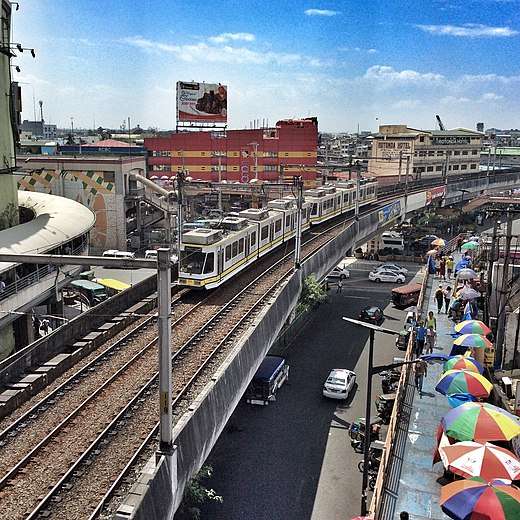LRT Line 1 (Metro Manila)
The Light Rail Transit Line 1 commonly referred to as LRT Line 1 or LRT-1 is a light metro line in Metro Manila, Philippines, operated by Light Rail Manila Corporation (LRMC) and owned by the Light Rail Transit Authority (LRTA) as part of the Manila Light Rail Transit System. Currently, the line consists of 20 stations and runs on 19.65 kilometers (12.21 mi) of fully elevated route.
| LRT Line 1 | |||||||||||||||||||||||||||||||||||||||||||||||||||||||||||||||||||||||||||||||||||||||||||||||||||||||||||||||||||||||||||||||||||||||||||||||||||||||||||||||||||||||||||||||||||||||||||||||||||||||||||||||||||||||||||||||||||||||||||||||||||||||||||||||||||||||||||||||||||||||||||||||||||||||
|---|---|---|---|---|---|---|---|---|---|---|---|---|---|---|---|---|---|---|---|---|---|---|---|---|---|---|---|---|---|---|---|---|---|---|---|---|---|---|---|---|---|---|---|---|---|---|---|---|---|---|---|---|---|---|---|---|---|---|---|---|---|---|---|---|---|---|---|---|---|---|---|---|---|---|---|---|---|---|---|---|---|---|---|---|---|---|---|---|---|---|---|---|---|---|---|---|---|---|---|---|---|---|---|---|---|---|---|---|---|---|---|---|---|---|---|---|---|---|---|---|---|---|---|---|---|---|---|---|---|---|---|---|---|---|---|---|---|---|---|---|---|---|---|---|---|---|---|---|---|---|---|---|---|---|---|---|---|---|---|---|---|---|---|---|---|---|---|---|---|---|---|---|---|---|---|---|---|---|---|---|---|---|---|---|---|---|---|---|---|---|---|---|---|---|---|---|---|---|---|---|---|---|---|---|---|---|---|---|---|---|---|---|---|---|---|---|---|---|---|---|---|---|---|---|---|---|---|---|---|---|---|---|---|---|---|---|---|---|---|---|---|---|---|---|---|---|---|---|---|---|---|---|---|---|---|---|---|---|---|---|---|---|---|---|---|---|---|---|---|---|---|---|---|---|---|---|---|---|---|---|---|---|---|---|---|---|---|---|---|---|---|---|---|---|---|
 | |||||||||||||||||||||||||||||||||||||||||||||||||||||||||||||||||||||||||||||||||||||||||||||||||||||||||||||||||||||||||||||||||||||||||||||||||||||||||||||||||||||||||||||||||||||||||||||||||||||||||||||||||||||||||||||||||||||||||||||||||||||||||||||||||||||||||||||||||||||||||||||||||||||||
A two-car LRTA Class 1000 train | |||||||||||||||||||||||||||||||||||||||||||||||||||||||||||||||||||||||||||||||||||||||||||||||||||||||||||||||||||||||||||||||||||||||||||||||||||||||||||||||||||||||||||||||||||||||||||||||||||||||||||||||||||||||||||||||||||||||||||||||||||||||||||||||||||||||||||||||||||||||||||||||||||||||
| Overview | |||||||||||||||||||||||||||||||||||||||||||||||||||||||||||||||||||||||||||||||||||||||||||||||||||||||||||||||||||||||||||||||||||||||||||||||||||||||||||||||||||||||||||||||||||||||||||||||||||||||||||||||||||||||||||||||||||||||||||||||||||||||||||||||||||||||||||||||||||||||||||||||||||||||
| Type | Light rapid transit | ||||||||||||||||||||||||||||||||||||||||||||||||||||||||||||||||||||||||||||||||||||||||||||||||||||||||||||||||||||||||||||||||||||||||||||||||||||||||||||||||||||||||||||||||||||||||||||||||||||||||||||||||||||||||||||||||||||||||||||||||||||||||||||||||||||||||||||||||||||||||||||||||||||||
| System | Manila Light Rail Transit System | ||||||||||||||||||||||||||||||||||||||||||||||||||||||||||||||||||||||||||||||||||||||||||||||||||||||||||||||||||||||||||||||||||||||||||||||||||||||||||||||||||||||||||||||||||||||||||||||||||||||||||||||||||||||||||||||||||||||||||||||||||||||||||||||||||||||||||||||||||||||||||||||||||||||
| Status | Operational | ||||||||||||||||||||||||||||||||||||||||||||||||||||||||||||||||||||||||||||||||||||||||||||||||||||||||||||||||||||||||||||||||||||||||||||||||||||||||||||||||||||||||||||||||||||||||||||||||||||||||||||||||||||||||||||||||||||||||||||||||||||||||||||||||||||||||||||||||||||||||||||||||||||||
| Locale | Metro Manila, Philippines | ||||||||||||||||||||||||||||||||||||||||||||||||||||||||||||||||||||||||||||||||||||||||||||||||||||||||||||||||||||||||||||||||||||||||||||||||||||||||||||||||||||||||||||||||||||||||||||||||||||||||||||||||||||||||||||||||||||||||||||||||||||||||||||||||||||||||||||||||||||||||||||||||||||||
| Termini | Roosevelt Baclaran | ||||||||||||||||||||||||||||||||||||||||||||||||||||||||||||||||||||||||||||||||||||||||||||||||||||||||||||||||||||||||||||||||||||||||||||||||||||||||||||||||||||||||||||||||||||||||||||||||||||||||||||||||||||||||||||||||||||||||||||||||||||||||||||||||||||||||||||||||||||||||||||||||||||||
| Stations | 20 | ||||||||||||||||||||||||||||||||||||||||||||||||||||||||||||||||||||||||||||||||||||||||||||||||||||||||||||||||||||||||||||||||||||||||||||||||||||||||||||||||||||||||||||||||||||||||||||||||||||||||||||||||||||||||||||||||||||||||||||||||||||||||||||||||||||||||||||||||||||||||||||||||||||||
| Services | 1 | ||||||||||||||||||||||||||||||||||||||||||||||||||||||||||||||||||||||||||||||||||||||||||||||||||||||||||||||||||||||||||||||||||||||||||||||||||||||||||||||||||||||||||||||||||||||||||||||||||||||||||||||||||||||||||||||||||||||||||||||||||||||||||||||||||||||||||||||||||||||||||||||||||||||
| Daily ridership | 453,000 daily (2018) [1] | ||||||||||||||||||||||||||||||||||||||||||||||||||||||||||||||||||||||||||||||||||||||||||||||||||||||||||||||||||||||||||||||||||||||||||||||||||||||||||||||||||||||||||||||||||||||||||||||||||||||||||||||||||||||||||||||||||||||||||||||||||||||||||||||||||||||||||||||||||||||||||||||||||||||
| Line number | 1 | ||||||||||||||||||||||||||||||||||||||||||||||||||||||||||||||||||||||||||||||||||||||||||||||||||||||||||||||||||||||||||||||||||||||||||||||||||||||||||||||||||||||||||||||||||||||||||||||||||||||||||||||||||||||||||||||||||||||||||||||||||||||||||||||||||||||||||||||||||||||||||||||||||||||
| Website | LRTA, LRMC | ||||||||||||||||||||||||||||||||||||||||||||||||||||||||||||||||||||||||||||||||||||||||||||||||||||||||||||||||||||||||||||||||||||||||||||||||||||||||||||||||||||||||||||||||||||||||||||||||||||||||||||||||||||||||||||||||||||||||||||||||||||||||||||||||||||||||||||||||||||||||||||||||||||||
| Operation | |||||||||||||||||||||||||||||||||||||||||||||||||||||||||||||||||||||||||||||||||||||||||||||||||||||||||||||||||||||||||||||||||||||||||||||||||||||||||||||||||||||||||||||||||||||||||||||||||||||||||||||||||||||||||||||||||||||||||||||||||||||||||||||||||||||||||||||||||||||||||||||||||||||||
| Opened | December 1, 1984[2] | ||||||||||||||||||||||||||||||||||||||||||||||||||||||||||||||||||||||||||||||||||||||||||||||||||||||||||||||||||||||||||||||||||||||||||||||||||||||||||||||||||||||||||||||||||||||||||||||||||||||||||||||||||||||||||||||||||||||||||||||||||||||||||||||||||||||||||||||||||||||||||||||||||||||
| Owner | Department of Transportation – Light Rail Transit Authority | ||||||||||||||||||||||||||||||||||||||||||||||||||||||||||||||||||||||||||||||||||||||||||||||||||||||||||||||||||||||||||||||||||||||||||||||||||||||||||||||||||||||||||||||||||||||||||||||||||||||||||||||||||||||||||||||||||||||||||||||||||||||||||||||||||||||||||||||||||||||||||||||||||||||
| Operator(s) |
| ||||||||||||||||||||||||||||||||||||||||||||||||||||||||||||||||||||||||||||||||||||||||||||||||||||||||||||||||||||||||||||||||||||||||||||||||||||||||||||||||||||||||||||||||||||||||||||||||||||||||||||||||||||||||||||||||||||||||||||||||||||||||||||||||||||||||||||||||||||||||||||||||||||||
| Rolling stock | LRTA 1000 class LRTA 1100 class LRTA 1200 class | ||||||||||||||||||||||||||||||||||||||||||||||||||||||||||||||||||||||||||||||||||||||||||||||||||||||||||||||||||||||||||||||||||||||||||||||||||||||||||||||||||||||||||||||||||||||||||||||||||||||||||||||||||||||||||||||||||||||||||||||||||||||||||||||||||||||||||||||||||||||||||||||||||||||
| Technical | |||||||||||||||||||||||||||||||||||||||||||||||||||||||||||||||||||||||||||||||||||||||||||||||||||||||||||||||||||||||||||||||||||||||||||||||||||||||||||||||||||||||||||||||||||||||||||||||||||||||||||||||||||||||||||||||||||||||||||||||||||||||||||||||||||||||||||||||||||||||||||||||||||||||
| Track length | 19.65 km (12.21 mi) 31.35 km (19.48 mi) (2022) | ||||||||||||||||||||||||||||||||||||||||||||||||||||||||||||||||||||||||||||||||||||||||||||||||||||||||||||||||||||||||||||||||||||||||||||||||||||||||||||||||||||||||||||||||||||||||||||||||||||||||||||||||||||||||||||||||||||||||||||||||||||||||||||||||||||||||||||||||||||||||||||||||||||||
| Number of tracks | 2 | ||||||||||||||||||||||||||||||||||||||||||||||||||||||||||||||||||||||||||||||||||||||||||||||||||||||||||||||||||||||||||||||||||||||||||||||||||||||||||||||||||||||||||||||||||||||||||||||||||||||||||||||||||||||||||||||||||||||||||||||||||||||||||||||||||||||||||||||||||||||||||||||||||||||
| Track gauge | 1,435 mm (4 ft 8 1⁄2 in) standard gauge | ||||||||||||||||||||||||||||||||||||||||||||||||||||||||||||||||||||||||||||||||||||||||||||||||||||||||||||||||||||||||||||||||||||||||||||||||||||||||||||||||||||||||||||||||||||||||||||||||||||||||||||||||||||||||||||||||||||||||||||||||||||||||||||||||||||||||||||||||||||||||||||||||||||||
| Electrification | Overhead lines | ||||||||||||||||||||||||||||||||||||||||||||||||||||||||||||||||||||||||||||||||||||||||||||||||||||||||||||||||||||||||||||||||||||||||||||||||||||||||||||||||||||||||||||||||||||||||||||||||||||||||||||||||||||||||||||||||||||||||||||||||||||||||||||||||||||||||||||||||||||||||||||||||||||||
| Operating speed | Monumento-Baclaran: 40 km/h (25 mph) Roosevelt-Monumento: 60 km/h (37 mph) Design speed: 80 km/h (50 mph) | ||||||||||||||||||||||||||||||||||||||||||||||||||||||||||||||||||||||||||||||||||||||||||||||||||||||||||||||||||||||||||||||||||||||||||||||||||||||||||||||||||||||||||||||||||||||||||||||||||||||||||||||||||||||||||||||||||||||||||||||||||||||||||||||||||||||||||||||||||||||||||||||||||||||
| |||||||||||||||||||||||||||||||||||||||||||||||||||||||||||||||||||||||||||||||||||||||||||||||||||||||||||||||||||||||||||||||||||||||||||||||||||||||||||||||||||||||||||||||||||||||||||||||||||||||||||||||||||||||||||||||||||||||||||||||||||||||||||||||||||||||||||||||||||||||||||||||||||||||
It travels in a general north–south direction from Baclaran to Monumento, and then east–west from Monumento to Roosevelt. The line links the cities of Quezon City, Caloocan, Manila, Pasay, and Parañaque. Passengers may transfer to Line 2 at Doroteo Jose station and to Line 3 at EDSA station.
A 1977 study conducted by Freeman Fox and Associates suggested a street-level railway in Manila, but the government revised this recommendation to an elevated system. On July 12, 1980, President Ferdinand Marcos created the LRTA and construction of the line began the following year. With the opening of its first segment on December 1, 1984, it became the first rapid transit service in Southeast Asia.
Originally referred to as Metrorail and the Yellow Line, Line 1 was reclassified to be the Green Line in 2012. Future plans include an eight-station southbound extension into the province of Cavite by 2022 and an eventual extension to the North Avenue Grand Central Station which will provide additional connections to MRT Line 3, MRT Line 7 and the Metro Manila Subway.
Route
Line 1 is predominantly aligned to the path of Taft Avenue (Radial Road 2) which was chosen largely due to its straight course. Later on, as Taft Avenue ends, it shifts to Rizal Avenue and Rizal Avenue Extension (Radial Road 9) then turning right at EDSA or Circumferential Road 4 (C-4 Road) before ending at the corner of North and West Avenues and EDSA.
Stations
(2017-05-10).jpg)


The line serves 20 stations along its route. A twenty-first station is yet to be constructed.[3] Eight stations which are part of the Line 1 South Extension Project are also set to be constructed south of Baclaran.
A previously proposed station, Malvar station in Caloocan was proposed during the construction of the northern extension and became a bargaining object during its construction and has since been shelved by the current administration.
| Key | |
|---|---|
| † | Existing terminus |
| Name | Distance (km) | Transfers | Location | |
|---|---|---|---|---|
| Between stations | From Roosevelt | |||
| North Avenue Grand Central Station | — | — | 3 MRT Line 37 MRT Line 7 MMS Metro Manila Subway | Quezon City |
| Roosevelt † | — | 0.000 | — | |
| Balintawak | 1.870 | 1.870 | — | |
| Monumento | 2.250 | 4.120 | — | Caloocan |
| 5th Avenue | 1.087 | 5.207 | — | |
| R. Papa | 0.954 | 6.161 | — | Manila |
| Abad Santos | 0.660 | 6.821 | — | |
| Blumentritt | 0.927 | 7.748 | ||
| Tayuman | 0.671 | 8.419 | — | |
| Bambang | 0.618 | 9.037 | — | |
| Doroteo Jose | 0.648 | 9.685 | ||
| Carriedo | 0.685 | 10.370 | — | |
| Central Terminal | 0.725 | 11.095 | — | |
| United Nations | 1.214 | 12.309 | — | |
| Pedro Gil | 0.754 | 13.063 | — | |
| Quirino | 0.794 | 13.857 | — | |
| Vito Cruz | 0.827 | 14.684 | — | |
| Gil Puyat | 1.061 | 15.745 | — | Pasay |
| Libertad | 0.730 | 16.475 | — | |
| EDSA | 1.010 | 17.485 | 3 MRT Line 3 via Taft Avenue | |
| Baclaran † | 0.588 | 18.073 | — | |
| Redemptorist | — | — | — | Parañaque |
| Manila International Airport | — | — | — | |
| Asia World | — | — | ||
| Ninoy Aquino | — | — | — | |
| Dr. Santos | — | — | — | |
| Las Piñas | — | — | — | Las Piñas |
| Zapote | — | — | — | Bacoor, Cavite |
| Niog | — | — | — | |
| Note: Stations or lines in italics are under construction | ||||
History
Planning and funding
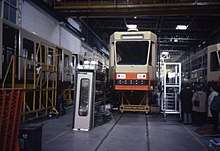
In 1977, the results of a fourteen-month study conducted by Freeman Fox and Associates and funded by the World Bank recommended the construction of a street-level light rail line in Manila. Following a review by the Ministry of Transportation and Communications, later the Department of Transportation (DOTr), the proposal was revised to an elevated railway in order to avoid building over the city's many intersections. This raised the project's cost from ₱1.5 billion to ₱2 billion. An alignment along Rizal and Taft avenues, which spanned from Monumento, Caloocan in the north to Baclaran, Pasay in the south, was selected because it followed a relatively straight path for most of its route.[4]:36 On July 12, 1980, President Ferdinand Marcos created the Light Rail Transit Authority (LRTA) and assigned First Lady and Governor of Metro Manila Imelda Marcos as its chairman. While the LRTA confined its roles to policy making, fare regulation, and future planning, the line's operations were assigned to Metro, Inc., a sister company of Meralco. The line came to be referred to as Metrorail.[5]
The Belgian Government granted a ₱300 million soft and interest-free loan for the project's construction, with a repayment period of 30 years. Additional funding was later sourced from a ₱700 million loan, provided by a Belgian consortium consisting of ACEC, La Brugeoise et Nivelles, Tractionnel Engineering International, and Transurb Consult. The consortium also supplied the line's first light rail vehicles, power control, signalling, and telecommunications, as well as provided training and technical assistance. Designed as a public utility rather than a profit center, the line was expected to incur a deficit through 1993, but complete its repayments within a period of 20 years.[5]
Construction and opening
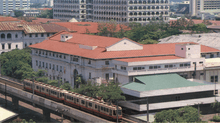
The government-owned Construction Development Corporation of the Philippines was the project's sole contractor.[4]:36 In 1981, an economic recession and the government's inability to provide counterpart funds for civil works and right-of-way acquisition, which amounted to 60 percent of the project's total cost, led to a delay in construction.[6]:170 Work finally began in September of that year along Taft Avenue, between Epifanio de los Santos Avenue (EDSA) and Libertad Street.[7] In order to make way for Carriedo station and a segment of tracks approaching the Pasig River, a department store and a classroom building owned by FEATI University were demolished.[4]:36 The southern section, between the Baclaran to United Nations stations, was inaugurated on September 11, 1984, and commercial operation along this section commenced the following December 1. The entire line subsequently became fully operational on May 13, 1985. During the first several years, two-car trains that could accommodate up to 748 passengers were utilized. This amounted to a capacity of 20,000 passengers per direction.[8]
- May 12, 1985: Central Terminal to Monumento
Later extensions
- March 22, 2010: Balintawak
- October 22, 2010: Roosevelt
On October 12, 2014, Light Rail Manila Corporation (LRMC), a joint venture company of Metro Pacific's Metro Pacific Light Rail Corporation (MPLRC), Ayala Corporation’s AC Infrastructure Holdings Corporation (AC Infra), and the Philippine Investment Alliance for Infrastructure’s Macquarie Infrastructure Holdings (Philippines) PTE Ltd.(MIHPL), signed a concession agreement with the DOTr and LRTA for the operation and maintenance of Line 1 and the construction of a PhP 65 billion extension project to Bacoor, Cavite.[9][10] LRMC, in turn, contracted the operation and maintenance of the line for 20 years to RATP Dev under its subsidiary RATP Dev Transdev Asia, a joint venture between Transdev and RATP Dev.[11][12] The 32-year concession started on September 12, 2015.
On May 29, 2020, the Japanese company Sumitomo Corp, which currently maintains the MRT Line 3, acquired a 34.9-percent stake of the Ayala-MPIC consortium.[13]
Rolling stock
The line at various stages in its history has used different configurations of two-car, three-car, and four-car trainsets. The two-car trains are the original first-generation BN and ACEC trains (railway cars numbered from 1000). Most were transformed into three-car trains, although some two-car trains remain in service. The four-car trains are the more modern second-generation Hyundai Precision and Adtranz (1100) and third-generation Kinki Sharyo / Nippon Sharyo (1200) trains.[14][15] There are 139 railway cars grouped into 40 trains serving the line: 63 of these are first-generation cars, 28 second-generation, and 48 third-generation. One train car (1037) was severely damaged in the Rizal Day bombings and was subsequently decommissioned.[16][17] The maximum speed of these cars is 80 km/h (50 mph), but currently run at a safe speed of 40 to 60 km/h (25 to 37 mph).[18][19]
The line's fleet is being modernized to cope with increasing numbers of passengers. In the initial phase of its capacity expansion program completed in 1999, the line's seven four-car second-generation trains were commissioned providing an increased train capacity of 1,350 passengers while the original two-car trains capable of holding 748 passengers were transformed into three-car trains with room for 1,122.[14]
The acquisition marked the introduction of the first air-conditioned trains to the line. Earlier rolling stock was notorious for its lack of air conditioning, relying instead on forced-air roof ventilation for cooling.[20] Unfortunately, this resulted in hot and stuffy rides. The problem was addressed more fully after a preparatory rehabilitation program completed in 2001 allowed the installation of air conditioners to the older rolling stock.[21] By June 2004, all Yellow Line trains had air conditioning.[22][23]
As part of the second phase of expansion on the Yellow Line, 12 new trains made in Japan by Kinki Sharyo and provided by the Manila Tren Consortium were shipped in the third quarter of 2006 and went into service in the first quarter of 2007. The new air-conditioned trains have boosted the capacity of the line from 27,000 to 40,000 passengers per hour per direction.[15][24][25]
As of recent, the original trainsets are undergoing a body repaint and repair to address body issues and put it at par with its newer trains in terms of aesthetics. The idle and bogged down 2G trains, reduced to 2 running sets, have been a subject of an extensive rehabilitation program.[26] The rehabilitation resulted in revived second generation units with modernized electronics, new traction controllers and motors. 4 of the coaches in the third-generation trains that are currently out of service is the trainset that figured in the train collision in Roosevelt station.
LRMC has also built an in-house laboratory for production, manufacturing, fabrication and repair of train parts that are no longer available in the market.
Production of new rolling stock is awarded to Mitsubishi Corporation and manufacturing partner CAF, together with JICA, valued at P64.9 billion for 120 cars, or 30 train sets, to the line, in order to cover its Cavite Extension, and able to service more passengers. The train sets will be delivered from 2020 to 2022.[27][28]
The Passenger Assist Railway Display System, a passenger information system powered by LCD screens installed near the ceiling of the train that shows news, advertisements, current train location, arrivals and station layouts, are already installed in the Trains, along with the Line 2 and the Line 3.
| Rolling stock | First-generation | Second-generation | Third-generation | Fourth-generation |
|---|---|---|---|---|
| Image | 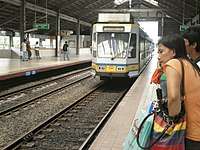 |
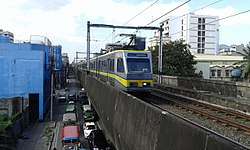 |
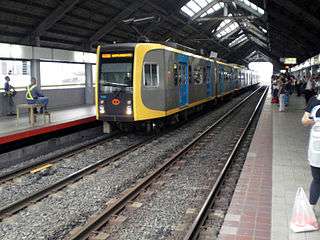 |
|
| Year | 1984 | 1999 | 2007 | fiscal 2021 |
| Manufacturers | BN Constructions Ferroviaires et Métalliques / SA Ateliers de Constructions Electriques de Charleroi | Hyundai Precision / Adtranz | Kinki Sharyo / Nippon Sharyo | Mitsubishi / Construcciones y Auxiliar de Ferrocarriles |
| Model | Class 1000 | Class 1100 | Class 1200 | Class 1300 |
| Number built (cars) | 64 built (41 in service, 15 out of service, 8 decommissioned) | 28 built (24 in service, 8
4 out of service, under rehabilitation) |
48 built (44 in service, 4 out of service) |
120 ordered; 30 4-car sets to be built |
| Car type | 8-axle (4 bogie) rigid body | 6-axle (3 bogie) rigid body | 8-axle (4 bogie) rigid body | |
| Car length | 29280 mm | 26500 mm (MC car w/ coupler) 26350 mm (M Car w/anti-climber/semi permanent coupler) |
||
| Width | 2500 mm | 2590 mm | ||
| Height (From top of rail) | 3525 mm | 3740 mm | 3910 mm | |
| Configuration | 2 car: MC-MC 59590 mm 3 car: MC-MC-MC 89370 mm |
2 car: MC-MC 53000 mm 3 car: MC-M-MC 79350 mm 4 car: MC-M-M-MC 105700 mm |
4 car: MC-M-M-MC | |
| Articulation | Double | Single | ||
| Capacity | 748 to 1,122 passengers (81 seated, 293 standing) |
1,358 passengers (320 seated, 1038 standing) |
1,388 passengers (272 seated, 1116 standing @ 7 passengers/m²) | 276 seated @ 7 passengers/m² (no info on standing capacity yet) |
| Doors | 1400 mm wide; Plug-type; 5-doors/side | 1500 mm wide x 1900 mm high; Interior sliding type; 4-doors/side | Interior sliding-type; 4-doors/side | |
| Traction system | DC 218 kW Chopper Type x 1 | AC 125 kW VVVF Type with regeneration x 2 |
AC 105 kW VVVF Control with regeneration x 2 |
|
| Traction power | 750 V DC OCS; pantograph power connection | |||
| Body Material | BI sheet | Stainless steel | ||
| Ventilation | Forced ventilation (pre–2003 refurbishment);
12 units/car Air-conditioned; roof-mounted duct type; 5 units/car (refurbished) Air-conditioned & Forced ventilation Dome Air Vent PowerCool BR26 Brown; Advent AC135 RV Air Conditioner Cabs; 1 (Advent Air) unit/cab (refurbished) roof-mounted duct type; 1 (BR26) & 4 units/car (refurbished) |
Air-conditioned; roof-mounted duct type; 2 units/car | Air-conditioned | |
| Status | In service;
rehabilitated in 2003–2004 and 2016; 2019–present |
In Service | Ordered | |
Ridership
The ridership of the line reaches from 300,000 passengers daily, to as much as 500,000 passengers daily due to an increased number of trains, as well as reduced waiting time of passengers from 5 minutes to as much as 2–3.5 minutes,[32][33] having as much as 14.63 million passengers monthly,[32] and aims to increase the number of passengers riding the line to 800,000 as the Cavite extension is set to be finished next year (2021).[33]
Plans
South Extension Phase 1 (Line 1 South Extension)
A south extension of Line 1, also known as the South Extension Project or the Cavite Extension Project in the Metro Manila Rail Plans has been proposed and would aim to serve the areas of Parañaque to Cavite. Such an extension would take Quirino Avenue (Road from Parañaque to Bacoor) then would travel on the side of Seaside Drive to the Coastal Road, and from there would travel down the side of Kabihasnan street to Quirino Avenue (again) to its extension, General Emilio Aguinaldo Avenue from the Las Pinas-Bacoor Boundary of Zapote Bridge to Niog station. The extension would add 8 stations over some 11.7 kilometers (7.3 mi) of new line and would be the third rail line extending outside the Metro Manila area (after the east extension of Line 2 and the construction of Line 7).
An unsolicited bid to conduct this work from Canada's SNC-Lavalin was rejected by the Philippine government in 2005.[34] In 2006, the government worked with advisers (International Finance Corporation, White & Case, Halcrow and others) to conduct an open-market invitation to tender for the extension and for a 30-year concession to run the extended line. President Gloria Macapagal Arroyo subsequently withdrew the project.
The Line 1 South Extension Project will consist of the following eight stations:
- Redemptorist – Parañaque
- Manila International Airport – Parañaque
- Asia World – Parañaque
- Ninoy Aquino – Parañaque
- Dr. Santos – Parañaque
- Las Piñas – Las Piñas
- Zapote – along the boundaries of Bacoor and Las Piñas
- Niog – Bacoor
On May 4, 2017, the groundbreaking for the South Extension Project was held.[35] DOTr secretary Arthur Tugade projected the early completion of the project to be by 2020.[36][37]
The line would be extended from Parañaque southwards, connecting Las Piñas and Bacoor to the Mega Manila railway network. Civil works on the extension began on May 7, 2019 after the right-of-way was cleared. According to the latest update, the project is 48.32% complete as of July 30, 2020. The five stations from Baclaran to Dr. Santos in Parañaque are targeted to be partially operational by fourth quarter of 2021 while the remaining two stations in Las Piñas and Niog in Bacoor, Cavite will be completed by 2022.
Incidents and accidents
Rizal Day bombings
On Rizal Day in the year 2000, a Yellow Line train (Car number 1037) exploded near Blumentritt station as part of a series of explosions in a terrorist attack known as the Rizal Day bombings. The attack on the line killed some 22 people and injured hundreds. Eight members of both Jemaah Islamiyah and the Moro Islamic Liberation Front (MILF), which include Hambal, Asia's most wanted man, and Fathur Rahman al-Ghozi, were charged with plotting and masterminding the attacks in 2003, some three years after the attacks. Three suspects were put on trial,[38][39] with al-Ghozi receiving 17 years in prison due to the illegal possession of explosives. Al-Ghozi later died in a firefight after attempting to escape from prison. Car number 1037 is currently decommissioned, but there are plans to reconstruct it.
References
- Annual Report 2018 (PDF) (Report). Light Rail Transit Authority. December 31, 2018. p. 20. Archived from the original (PDF) on January 2, 2020. Retrieved January 2, 2020.
- http://cityrailtransit.com/timeline/manila_timeline.htm
- "Lines 1 and 2 Route Map". Light Rail Transit Authority. Archived from the original on May 28, 2014. Retrieved June 10, 2014.
- Satre, Gary L. (June 1998). "The Metro Manila LRT System — A Historical Perspective" (PDF). Japan Railway & Transport Review. Vol. 16. EJRCF. Retrieved June 11, 2019.
- "LRTA History". Light Rail Transit Authority. Archived from the original on June 9, 2019. Retrieved April 19, 2019.
- Provision of Travelway Space for Urban Public Transport in Developing Countries. UN-HABITAT. 1993. ISBN 9789211312201. Retrieved June 15, 2019.
- "The LRT Line 1 System – The Green Line". Light Rail Transit Authority. July 14, 2014. Archived from the original on July 14, 2014. Retrieved July 14, 2014.CS1 maint: unfit url (link)
- Rimmer, Peter J. (2013). Rikisha to Rapid Transit: Urban Public Transport Systems and Policy in Southeast Asia. Elsevier. pp. 190–191. ISBN 9781483150529.
- "P65B Manila-Cavite Transit Project Underway". Social Patrol. Archived from the original on May 5, 2017. Retrieved May 8, 2017.
- "Company profile". Light Rail Manila Corporation. Archived from the original on June 7, 2020. Retrieved June 7, 2020.
- "Light Rail Manila Corp inks operation and maintenance contract with French firm RATP Dev for the LRT1 extension project". France in the Philippines and in Micronesia – Embassy of France in Manila. Retrieved February 4, 2018.
- "Philippines: Manila LRT-1 Cavite Extension" (PDF). International Finance Corporation. Retrieved February 4, 2018.
- "Japan's Sumitomo joins Pangilinan-Ayala consortium for LRT-1". ABS-CBN News. May 29, 2020. Retrieved May 29, 2020.
- The Line 1 Capacity Expansion Project (Phase I) Archived May 17, 2006, at the Wayback Machine. [ca. 2003]. Light Rail Transit Authority. Retrieved April 7, 2006.
- Kinki Sharyo. [ca. 2010]. Light Rail Transit Authority, Manila Philippines, Light Rail Vehicle. Retrieved March 8, 2010 from the Kinki Sharyo Website.
- "Light Rail Transit Authority Annual Report 2006" (PDF). Light Rail Transit Authority. Planning Department/MIS Division. 2007. pp. 18–20. Archived from the original (PDF) on July 8, 2008. Retrieved January 15, 2010.
- "List of the entire fleet of light rail vehicles of Line 1 and trainsets of Line 2 with other details". eFreedom of Information. Government of the Philippines. Retrieved February 27, 2017.
- Razon, Evangeline M. (June 1998). "The Manila LRT System" (PDF). Japan Railway and Transport Review. 16: 38–39. Retrieved December 15, 2009.
- Otaki, Tsutomu (2007). "The Commissioning – In Case of a Project in Manila" (PDF). KS World. Kinki Sharyo. 14: 12–13. Retrieved January 15, 2010.
- Ronda, Rainier Allan. (August 15, 2003). "No More 'Sweaty' Rides". The Philippine Star. Retrieved January 23, 2010.
- The Line 1 Rehabilitation I Project Phase 3 – Rolling Stock Rehabilitation Archived May 22, 2013, at the Wayback Machine. [ca. 2010]. Light Rail Transit Authority. Retrieved January 19, 2010.
- Varella, Benjie. (September 26, 2003). "Line 1 to have all air-conditioned trains by April". The Manila Times. Archived from the original on April 15, 2005. Retrieved April 7, 2006.
- "LRT Line 1 Capacity Expansion Project (Phase II): Package B". Light Rail Transit Authority. Archived from the original on May 22, 2013. Retrieved June 11, 2014. Retrieved April 7, 2006 from the LRTA Website.
- "3rd Generation LRV Mock Up on Display". Light Rail Transit Authority. March 9, 2006. Archived from the original on April 24, 2006. Retrieved April 7, 2006.
- Olchondra, Riza T. (December 7, 2006). "'3G' trains to serve LRTA riders Dec. 11: More comfortable, safer rides assured for commuter Archived February 22, 2013, at Archive.today". Philippine Daily Inquirer. Retrieved February 7, 2010.
- Camus, Miguel R. (February 23, 2018). "LRMC signs P450-M deal for train rehab, upgrade". Inquirer.net.
- Camus, Miguel R. (November 21, 2017). "LRT-1 to get new train cars from Japan's Mitsubishi". Inquirer.net.
- "CAF awarded Manila rolling stock contract". Metro Report International. November 20, 2017. Retrieved June 7, 2020.
- "MANILA LRT1 EXTENSION, OPERATIONS AND MAINTENANCE PROJECT" (PDF). Public-Private Partnership Center. June 2012. Retrieved June 7, 2020.
- "CAF TO SUPPLY 30 LRVS TO MANILA (THE PHILIPPINES)". Construcciones y Auxiliar de Ferrocarriles. Retrieved May 19, 2019.
- "MANILA LINE 1 LRV". Construcciones y Auxiliar de Ferrocarriles. Retrieved May 19, 2019.
- Mercurio, Richmond (September 23, 2018). "LRT-1 posts record 14.63 million ridership in August".
- Marsigan, Lorenz S. (May 24, 2018). "LRMC sees LRT 1 passengers increasing by 75% in 2021". BusinessMirror.
- Valencia, L. B. (September 15, 2004). "LRT1 Extension Expected to Start Construction by 2005". Manila Bulletin.
- Cordero, Ted (July 4, 2018). "Tugade says LRT1 Cavite extension to be completed in 2021". GMA News Online. Retrieved July 8, 2018.
- Barrow, Keith (May 4, 2017). "Manila breaks ground on LRT 1 Cavite extension". International Railway Journal. Simmons-Boardman Publishing. Retrieved May 4, 2017.
- Cordero, John Ted (May 4, 2017). "DOTr, LRMC break ground for LRT-1 Cavite extension project". GMA News Online. Retrieved May 5, 2017.
- Tubeza, Philip (July 8, 2003). "Terrorist raps filed vs Asia's most wanted man". Inquirer. Philippine Daily Inquirer. Archived from the original on December 6, 2003.
- "DOJ Indicts Asia's Most Wanted Terrorist in 2000 LRT Bombing". Department of Justice (Republic of the Philippines). July 7, 2003. Archived from the original on July 25, 2008.
